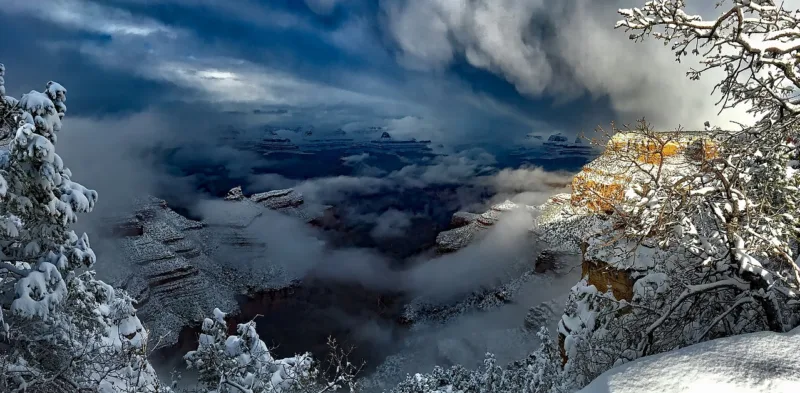Welcome to a comprehensive guide on Grand Canyon weather, where we unravel the mysteries of this natural wonder’s ever-changing climate. Whether you’re planning a trip or just curious about the fascinating meteorological phenomena surrounding the Grand Canyon, you’ve come to the right place.
Understanding Grand Canyon’s Unique Climate
Grand Canyon National Park boasts a diverse climate due to its vast elevation changes. The canyon’s north rim stands at over 8,000 feet, while the south rim hovers around 7,000 feet. This disparity results in distinct weather patterns, making it crucial to grasp the intricacies of both rims.
South Rim Weather
The South Rim, a popular entry point for visitors, experiences a more temperate climate. Summers are warm, with temperatures ranging from 50°F to 80°F, providing ideal conditions for hiking and exploration. Winters, on the other hand, can be chilly, with temperatures ranging from 20°F to 40°F. Visitors should come prepared for diverse conditions throughout the year.
North Rim Weather
The North Rim, with its higher elevation, offers a cooler experience. Summers are milder, averaging 45°F to 75°F, making it an excellent escape from the scorching heat. Winters, however, bring snow and colder temperatures, ranging from 10°F to 30°F. If you plan to visit during winter, don’t forget to pack accordingly.
Factors Influencing Grand Canyon Weather
Several factors contribute to the dynamic weather at the Grand Canyon:
Altitude Changes
The significant elevation differences between the north and south rims play a pivotal role in shaping the diverse climate. Understanding these changes helps visitors prepare for the varying conditions they may encounter during their stay.
Seasonal Variations
Each season at the Grand Canyon offers a unique experience. From the vibrant blooms of spring to the awe-inspiring colors of fall, every moment presents an opportunity to witness nature’s grandeur. Knowing what to expect during each season enhances your visit.
Microclimates within the Canyon
The Grand Canyon contains multiple microclimates, influenced by its intricate topography. As you descend into the canyon, you’ll encounter temperature variations, adding another layer of complexity to your journey.
Best Times to Visit Based on Weather
Choosing the right time to visit the Grand Canyon can significantly impact your experience. Here’s a breakdown of the optimal seasons:
Spring
Spring, with its mild temperatures and blooming flora, offers a delightful experience. Hiking becomes more enjoyable, and the canyon comes to life with vibrant colors.
Fall
Fall brings cooler temperatures and a spectacle of changing foliage. The canyon’s beauty reaches a peak during this season, making it a favorite among photographers and nature enthusiasts.
Pro Tips for Weather-Resilient Grand Canyon Adventures
To make the most of your Grand Canyon expedition, consider these expert tips:
1. Layered Clothing
Given the varied temperatures, dressing in layers allows you to adapt to changing conditions seamlessly. This ensures comfort throughout your exploration.
2. Check Weather Forecasts
Stay informed about the latest weather forecasts for both rims. This knowledge empowers you to plan your activities accordingly, maximizing your enjoyment.
3. Hydration is Key
The dry climate demands proper hydration. Carry sufficient water, especially if you plan to hike or engage in physical activities.
Conclusion
In conclusion, understanding the nuances of Grand Canyon weather enhances your visit, allowing you to navigate its breathtaking landscapes with confidence. Embrace the diversity of this natural wonder and create memories that will last a lifetime.
Similar Articles
- Kofa National Wildlife Refuge: Discovering the Natural Wonders of Arizona
- 10 Best Day Trips from Sedona: Explore the Beauty of the Southwest
- Coconino National Forest: A Natural Wonderland in Northern Arizona
Frequently Asked Questions about Grand Canyon Weather
Q1: What is the typical weather at the Grand Canyon?
A1: The Grand Canyon experiences diverse weather due to its varying elevations. On the South Rim, summers are warm, ranging from 50°F to 80°F, while winters can be chilly, with temperatures from 20°F to 40°F. The North Rim, at a higher elevation, offers milder summers (45°F to 75°F) and colder winters (10°F to 30°F).
Q2: How do altitude changes impact the weather at the Grand Canyon?
A2: Altitude plays a significant role in shaping the Grand Canyon’s weather. The North Rim’s higher elevation results in cooler temperatures, affecting the climate on either side of the canyon. Understanding these altitude changes is essential for preparing for the diverse conditions you might encounter during your visit.
Q3: What are the best times to visit the Grand Canyon based on the weather?
A3: The optimal times to visit depend on personal preferences. Spring offers mild temperatures and blooming flora, making it delightful for hiking. Fall, with cooler temperatures and changing foliage, is a favorite among photographers and nature enthusiasts. Both seasons provide unique experiences.
Q4: Are there microclimates within the Grand Canyon?
A4: Yes, the Grand Canyon contains multiple microclimates influenced by its intricate topography. As you descend into the canyon, you’ll notice temperature variations. This adds complexity and diversity to the weather conditions, creating a unique experience for visitors.
Q5: How can I prepare for the changing weather at the Grand Canyon?
A5: To prepare for the dynamic weather, consider the following tips:
- Layered Clothing: Dress in layers to adapt to changing temperatures.
- Check Weather Forecasts: Stay informed about the latest forecasts for both the North and South Rims.
- Hydration is Key: Given the dry climate, ensure you stay adequately hydrated, especially during physical activities like hiking.
Q6: What activities are recommended during each season?
A6:
- Spring: Enjoy hiking amidst blooming flora and mild temperatures.
- Summer: Explore the canyon’s wonders, but be prepared for warmer weather.
- Fall: Capture the changing foliage and cooler temperatures, perfect for photography.
- Winter: Experience the unique beauty of snow-covered landscapes, but pack accordingly for colder conditions.
Q7: Can I expect consistent weather throughout the Grand Canyon?
A7: No, the weather at the Grand Canyon varies due to factors like altitude changes and seasonal variations. It’s essential to be flexible and prepared for diverse conditions during your visit.
Q8: How can I stay informed about Grand Canyon weather?
A8: Stay updated by checking reliable weather forecasts for both the North and South Rims. Many online platforms provide real-time weather information to help you plan your activities accordingly.
Q9: Are there any weather-related challenges at the Grand Canyon?
A9: While the weather adds to the canyon’s allure, visitors should be aware of potential challenges, such as sudden temperature changes and the need to stay adequately hydrated. Planning and preparation are key to a safe and enjoyable visit.
Q10: Where can I find more information about Grand Canyon weather?
A10: For additional insights and tips on Grand Canyon weather, you can visit authoritative sources or explore reputable travel websites. Staying informed ensures you make the most of your visit to this natural wonder.









